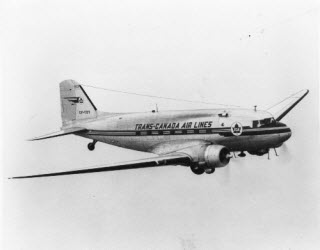The Douglas DC-3 airliner, owned by Trans-Canada Air Lines (now known as Air Canada).
In the early part of its second decade, the Department of Transport had a lot of catching up to do.
During the Second World War, improvements to departmental facilities had been postponed unless required for safety reasons. Now, as the department and the country returned to peacetime operations, there was a huge job to be done to bring those facilities up to necessary levels of efficiency.
In 1946/47, contracts for construction and repair projects amounted to almost $8 million, nearly double the total for the previous year. By 1947-48, the annual outlay had risen to $31 million.
While forging ahead with the upgrading of existing facilities, the department was also assuming ownership and management of properties built or purchased in the war years, such as ships and airports.
The department's operational activities were also expanding to meet the post-war boom as well as the addition of the country's 10th province. The entry of Newfoundland into Confederation had a greater impact on the Department of Transport than on any other federal agency. The department assumed responsibility for all of Newfoundland's transportation facilities that fell within federal jurisdiction and more than 1,100 transferred employees.
Air
Civil aviation mushroomed after the war, greatly increasing the department's licensing and regulatory activities, and calling for the operation by the department of a growing network of airports across the country.
The introduction of new aircraft, such as the four-engine North Star in the late 1940s, required the lengthening and strengthening of runways at major airports. New technology, such as the instrument landing system, was developed and installed at airports to ensure the safety of the rapidly growing number of air travellers.
The appearance of jet aircraft on the aviation scene had a major impact on the department's meteorology division, which was now called upon to provide weather forecasts at the 30,000-foot level or higher. The technology developed by the division soon became world-famous, and was being sold to several countries in Europe and Africa by 1949.
Marine
On the marine side, extensive work was done by the department during this period to increase the number of navigational aids in all waterways and to develop improved technology for all types of aids.
The C.D. Howe, a ship that was to become a household word in the Canadian North, was commissioned in 1950 to carry out supply work in the eastern Arctic. Also slated for a place in history was the newly commissioned d'Iberville, which represented Canada at the Coronation Review for Queen Elizabeth at Spithead in 1952.
Employee programs
The department's first programs to increase the well-being and morale of its employees were introduced by the personnel division in the early ‘50s. A group hospital and surgical expense insurance plan for employees and their dependents was established. A staff training and welfare division was set up to conduct courses and distribute information on the department's activities. The department's first employee newsletter, News on the DoT, also made its appearance.
Other developments
Other major activity in the department during this second decade of the department's operation focused on planning for the St. Lawrence Seaway project; the establishment of a Northern Transportation Division to look after the supply of northern communities; and the passage of the Motor Vehicle Transport Act in 1954, which transferred the administration (licensing) of interprovincial and international highway transportation to the provinces.
By 1956, the Department of Transport had a staff of more than 11,500 and annual expenditures of $136 million. Although the department had grown quickly to meet the country's postwar needs, rapid expansion in all modes of transportation and the increasing demand for services would continue to challenge its resources.
